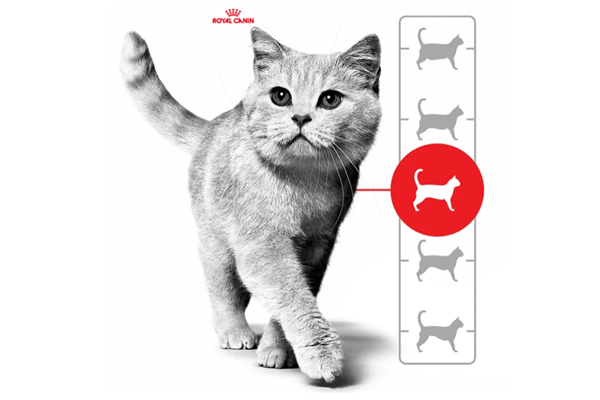A healthy weight is key to your cat’s health and wellbeing. Find out more about the four simple ways you can maintain your cat’s healthy weight and keep them in good shape.
1. Healthy weight isn’t only measured on a scale
Weighing your cat is not the only way to check if they’re overweight. You can find out if your cat’s a healthy weight by asking your vet how to use the Body Condition Score. Your vet can help you work out your cat’s body condition score. It’s also important to take your cat for regular visits so your vet can help you monitor their shape as they age.
The best way to keep track of your cat’s weight is by taking a regular 3-step look-feel-weigh approach.
Step 1: Cat’s behaviour. Are they somewhat lethargic and get tired quickly?
Step 2: Does their stomach sag or can you see their waist and the tuck of their abdomen behind their ribs? Can you feel the ribs with light pressure?
Step 3: Weigh your cat and make a note so you can compare next time. Your vet can give you an indication of your cat’s ideal weight based on their current weight and using the body condition score.
Cats become overweight when they eat more calories than they use, so the first thing to address is their food. Ask your vet about formulas designed specifically for overweight cats, because if you just decrease meal sizes with their current food it could cause nutritional deficiencies. At Royal Canin® we have a wide range of weight management products to help keep your cat at a healthy weight.
2. Healthy activity requires play
Playtime is key to keeping your cat stimulated, active and at a healthy weight. The amount of exercise varies based on factors such as their age, weight and breed. Cats are naturally active animals and thrive on short bursts of activity to keep both their bodies and minds active and engaged with the world.
Exercise and play are essential for all cats as they improve their motor skills, provide brain training and encourage social behaviour. Ensuring your cat has room to play, as well as access to a variety of different cat toys, scratching posts and play sessions with you will help them to stay healthy and happy.
3. Healthy portions are smaller than you think
Many pet owners think their cat needs more food than it really does. This means that many cats are overfed which can cause weight gain and lead to other health issues.
Healthy weight is achieved by maintaining the correct balance between the energy your cat takes in through their food, and the energy they use.
The starting point is to follow the feeding guide given by the cat food you have selected. However, a number of factors may also need to be taken into consideration when determining the portion size.
First, consider the activity levels of your cat; are they often on the move, do they spend a lot of time outdoors, or are they a more sedentary, indoor cat? How much exercise a cat gets will determine the calories they need throughout the day.
Next, has your cat been spayed or neutered? These procedures can impact the portions needed by your cat. Sterilization changes their metabolism and means they may need fewer calories.
Tips for maintaining the correct portions for your cat
It may seem challenging to maintain a healthy portion size for your cat, however there are a few of things you can be aware of to prevent overfeeding.
- Divide their ration into small, frequent meals. If you feed your cat dry food, measure out each meal carefully using scales, and leave it available for them to come back to until the next meal.
- If your cat eats all of their food before their next meal time, avoid simply topping up the bowl whenever it is empty. This can help to prevent overfeeding.
- Avoid feeding your cat any human food as even small amounts can represent a large percentage of their daily energy requirements.
- If you give your cat treats, it’s important to take those additional calories into account when calculating their daily ration. Treats should represent no more than 10% of your cat’s daily food allowance.
4. Healthy growth lasts a lifetime
Losing weight is more difficult than preventing weight gain in the first place, so it’s important that healthy habits and behaviours are set from day one. A healthy weight starts with healthy habits.
If your kitten eats more calories than they need each day, they’ll start to put on weight. Obesity in kittens can lead to a range of health problems in later life. To prevent such health risks for your young pet, it’s vital that you introduce healthy habits into their daily life from the start.
It’s better for your kitten to eat little and often, so try giving your kitten multiple small meals a day. To avoid overfeeding, always measure out your kitten’s daily food portion.
Kittens love to exercise and will thrive on short bursts of intense activity and play. Ensuring that these short bursts of playful activity happen regularly will help your pet to stay fit and healthy.
Find more information at: www.royalcanin.com

